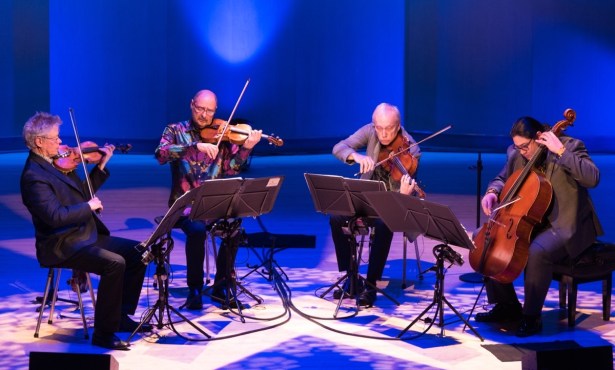Mark Morris Dance Group
At the Granada, Tuesday, May 20.

For his company’s first Santa Barbara performance in 20 years, Mark Morris chose a trio of older works: “New Love Song Waltzes” from 1982 and “Love Song Waltzes” from 1989, both set to the choral music of Johannes Brahms, and “Grand Duo” from 1993, set to Californian composer Lou Harrison’s score of the same name for violin and piano. As always, the company’s music ensemble performed live.
Brahms was inspired to write his 18 Liebeslieder walzer by the poetry of G.F. Daumer. “Listen: nothing will save you/if you go sailing on the sea of love,” Liebeslieder walzer Op. 65 begins, and continues, “It’s caulked with countless wrecks; their cargoes so much flotsam.” In “New Love Song Waltzes,” a single female dancer in a blue dress stood center stage, knees bent, body hinged backward, arms lifted in front of her as she swayed side-to-side like a listing ship. Then, in a rush, the other dancers swept on as if to rescue her. Women in black evening dresses and men in blue slacks and shirts darted and circled in formation, shuffling sideways in low, wide stances, carrying one another’s limp bodies on and off stage, running forward only to stop, suspended, as if filaments of thread were tugging their chests skyward.
“Love Song Waltzes” was more lyrical. The dancers wrapped their limbs around one another, waltzed in circles, and tossed their partners away one by one.
In these earlier works, which Morris refers to wryly as exemplifying his “ancient” style, awkward movements are common: loping backward runs with flexed feet, heavy footfalls, head movements that throw the body off center. There’s no real reason for this-these are abstract dances, not narratives-it’s more that Morris settles upon a language and sticks to it. In doing so, he makes visible the brilliant structure of his work, and every choreographic choice seems exactly right, whether it’s repetition, interruption, opposition, or unison.
Representing a later era of his work, “Grand Duo” transformed the dancers to primitive warriors, whose mysterious hand signals and stoic postures built until they were stomping and writhing in frenzy. Just as the action reached its peak, the lights went out.



